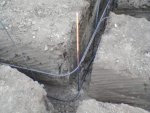Darren Emery
Member
- Location
- Manhattan, KS, USA
Hello all -
I have posted a few times in the past - but have been lurking here to learn more about the NEC for years. You all are a wealth of knowledge. Often my go-to when I need to study a topic in depth. Thank you!
I would really appreciate input regarding the CEE method in the picture below.
The IRC is our governing document for residential install, but it mirrors well the requirements from the NEC. By both codes, the rebar is allowed to be bonded together with wire tires, or other effective methods. I have always wondered if the intent of this language to allow for the appropriate lap splice of the rebar (approximately 24") to act as a bonding point, rather than the perpendicular intersection as shown.
My understanding of the CEE is that it relies on the extensive surface contact between either the wire or the bar (20' minimum) with the concrete to function correctly. If we consider the bottom bar in the trench shown as the actual CEE, the connection point at the intersection of the vertical painted bar to the horizontal bottom bar seems tome to be a weak point. . A 90deg bent bar, with at least 24" of bar to bar contact, and then wire tied, would offer a better path for current flow, IMO.
Thoughts on this?
(BTW - the bars will be lifted and fully encased in concrete when poured... not in conctact with the soil, just in case you were worried about that!)

I have posted a few times in the past - but have been lurking here to learn more about the NEC for years. You all are a wealth of knowledge. Often my go-to when I need to study a topic in depth. Thank you!
I would really appreciate input regarding the CEE method in the picture below.
The IRC is our governing document for residential install, but it mirrors well the requirements from the NEC. By both codes, the rebar is allowed to be bonded together with wire tires, or other effective methods. I have always wondered if the intent of this language to allow for the appropriate lap splice of the rebar (approximately 24") to act as a bonding point, rather than the perpendicular intersection as shown.
My understanding of the CEE is that it relies on the extensive surface contact between either the wire or the bar (20' minimum) with the concrete to function correctly. If we consider the bottom bar in the trench shown as the actual CEE, the connection point at the intersection of the vertical painted bar to the horizontal bottom bar seems tome to be a weak point. . A 90deg bent bar, with at least 24" of bar to bar contact, and then wire tied, would offer a better path for current flow, IMO.
Thoughts on this?
(BTW - the bars will be lifted and fully encased in concrete when poured... not in conctact with the soil, just in case you were worried about that!)


